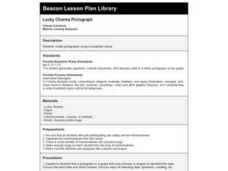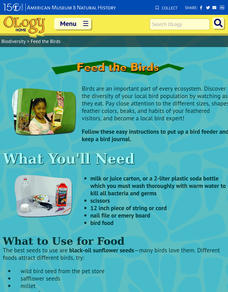Curated OER
Counting Calories
Students evaluate the health of breakfast foods. They create and solve word problems using cereal nutrition data. They solve additional problems formulated in class and write short essay on what they learned.
Curated OER
Optimization For Breakfast
Students identify he proportion of a cereal box. In this algebra lesson, students define the relationship between patterns, functions and relations. They model their understanding using the cereal box.
Curated OER
Weetabix: How much Cereal is in a Package?
In this algebra worksheet, students calculate the number of days that a box of Weetabix cereal would last a family. Weetabix comes with individual serving sizes, which make for easier calculations that will require dividing using...
Curated OER
The Breakfast Table
In this vocabulary interactive worksheet, students type the eight names of the utensils displayed in the illustration and complete an eight word word scramble.
Curated OER
Don't Worm Your Way Out of This One!
Learners study different aspects of worms along with the process of vermicomposting by participating in a class experiment to study the time it takes for breakfast cereal to be eaten by worms.
Curated OER
Breaking News English: Breakfast Helps Girls Stay Slim
In this English worksheet, students read "Breakfast Helps Girls Stay Slim," and then respond to 47 fill in the blank, 7 short answer, 20 matching, and 8 true or false questions about the selection.
Curated OER
Lucky Charms Pictograph
Third graders create pictographs using a breakfast cereal. This fun, hands-on lesson allows students to use Lucky Charms cereal to create a pictograph. When the lesson is through, 3rd graders get to eat their Lucky Charms marshmallows.
Curated OER
Introduction To the Classification of Organisms
Students discuss how scientists classify organisms. In pairs, they analyze and label "specimens" of breakfast cereals in order to classify them into the correct group. They create a dichotomous key for several species of animals.
Curated OER
The Young Virginia Gardener: Growing Seeds Indoors: Seeds for Breakfast
For this gardening worksheet, students answer a set of questions about seeds eaten form breakfast in cereals, 10 questions total.
Curated OER
Be an All Star
In this foods worksheet, students find the foods in the picture and circle the foods that are asked of them. Students circle 13 breakfast foods that are in Spanish.
Curated OER
Plan a Meal Fun
Discuss helping with the family grocery shopping. View a teacher drawn map of a grocery store and discuss where the breads, meats, and dairy products are located. Practice categorizing foods as breads and cereals, fruits, vegetables,...
Curated OER
Fit With Fiber
Sixth graders investigate the nutritional value of different types of cereal. They take a survey of students that ate breakfast and create a circle graph with the results. Students examine the nutritional information on the sides of the...
Curated OER
Healthy Breakfast
In this reading activity worksheet, students read a 1 page story about Mr. and Mrs. Jones. The story discusses their diet and exercise routines.
Curated OER
Honey Bunches of Oats
Students explore a variety of crops that are used in our food products utalizing a box of the cereal, Honey "Bunches of Oates." Percentages of each of the three different kinds of flakes present are calculated.
Curated OER
Iron for Breakfast
Students examine a common household food and see how accurate the content information is.
Curated OER
Minerals and You
Students study how mineral are used in everything around us-- from cereal to satellites. After informing the students about minerals they will discuss the ones that are in the area of the students.
Curated OER
Meal Planning Worksheet
In this meal planning worksheet, students record daily food choice on a chart that includes breakfast, lunch, dinner and snacks.
Curated OER
Feeding Frenzy
Young biologists take a look at the myriad of ways that animals increase their chances of surviving in the wild. The adaptations help animals hide, hunt, and attract a mate. This activity specifically explores how insect mouth parts are...
Baylor College
Serving Sizes
Are serving sizes for different foods always appropriate for what you need? In this hands-on activity, learners work in groups to estimate what one serving size of various foods are, and then evaluate their hypotheses by measuring...
Curated OER
Breaking News English: Slimming
In this slimming worksheet, learners read the article, answer true and false questions, complete synonym matching, complete phrase matching, complete a gap fill, answer short answer questions, answer discussion questions, write, and more...
Curated OER
Redox Titration of Iron
Students perform a redox titration of iron. In this iron titration lesson plan, students use potassium permanganate to oxidize iron so they can determine the percentage of iron in a sample of fertilizer.
McGraw Hill
Metric Units of Weight and Volume
Getting the right measurements can save a lot of time and money in the real world. Learners are introduced to unit conversion and how to accurately go from one unit to another. The first pages are notes and then the packet finishes with...
Nuffield Foundation
How Much Energy Is There in Food?
People associate calories with food, but what is a calorie? Young scientists measure the number of calories in samples of food to better understand the concept. They test a variety of samples, take measurements, and compare their results...
American Museum of Natural History
Feed the Birds
What kinds of birds are common in the area? Young scientists use household supplies to create bird feeders. They then document the birds that come to their feeders by keeping journals.

























